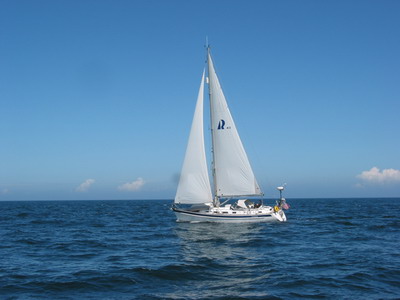
July 2007
Part Three
Morlaix to Brest, France
| |
| HOME |
| About Tenaya |
| About Us |
| Latest Update |
| Logs from Current Year |
| Logs from Previous Years |
| Katie's View |
| Route Map |
| Links |
| Contact Us |
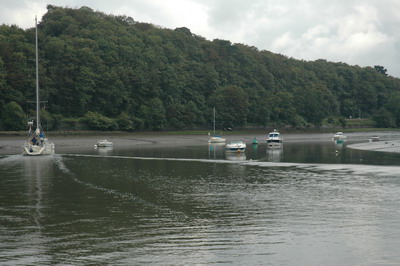
We set out in the morning to sail a short distance (a little over 20 miles) to Trebeurden. The weather was pleasant and we were able to actually sail for quite a while before the winds dropped and we had to turn on the motor. Our progress was good so we continued on to Morlaix, a pretty town up a river. Total distance for the day was 37 miles.
The trip was an easy one but turned exciting once we turned up the river. Expecting to hit ground at any time, we followed Talmar and navigated the river 8 miles to the town. It is a very narrow channel with a minimum depth (supposedly) of more than 2 meters. A good thing as Tenaya requires 2 meters. We crossed back and forth watching the depth gauge and hoping for the best.
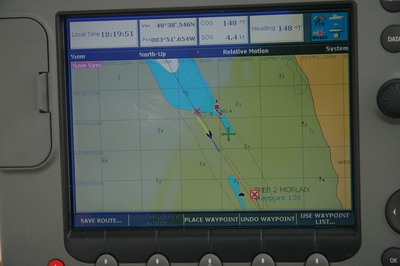
The charts, which always show depths at low tide, had us traveling 5 1/2 miles on dirt that was shown as 10 feet or more above sea level. It was my first time following our chart plotter for more than an hour and always showing Tenaya on dry land.
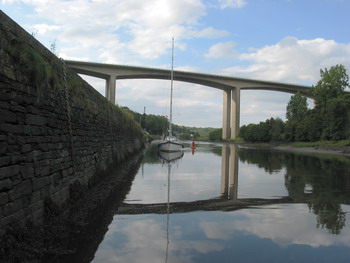
Just 20 meters before the waiting area for the lock into Morlaix we hit bottom and stuck in the mud. Talmar, drawing 1.8 meters, passed through and tied up to the wall. Luckily the the tide was still coming in so it quickly floated us. Then we were able to tie up to Talmar. Tenaya has touched bottom before but hasn't stuck. This was a new feeling and we were happy the tide was in our favor.
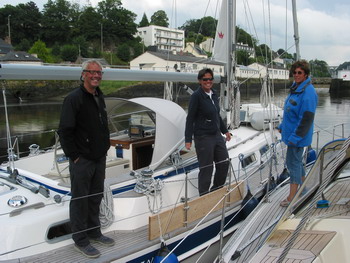
The Romans had a fortress at Morlaix and later, in the Middle Ages it was an important port and shipbuilding town. There were many battles between Morlaix and the British and was once captured by the British. In 1542 the Chateau de Taureau was built near the mouth of the river to protect the town.
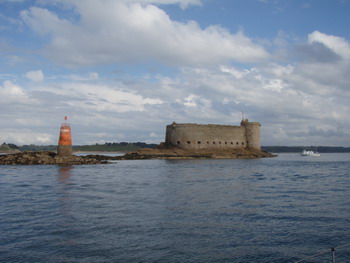
Chateau de Taureau near the River's entrance.
On July 20 we left Morlaix quickly after Jim and Sietse decided the weather was right. Each day we delayed leaving would put us into Brest an hour later so we didn't really want to dally. Too bad, it was a nice town and we would have liked to have explored a bit more. Such is the nature of this lifestyle though! We took off for L'Aberwrac'h. This port is the usual stopping point for boats planning to sail through the Chenal du Four.
The Chenal du Four is the second of our barriers going south (the first was the Alderney Race) with a narrow area surrounded by rocks and with a very fast tidal stream. But with good planning it can be a nice sail. We planned our departure from L'Aberwrac'h to arrive at the start of the channel at slack tide. It went quite smoothly and we had nice weather, good wind and no scary moments in the channel.
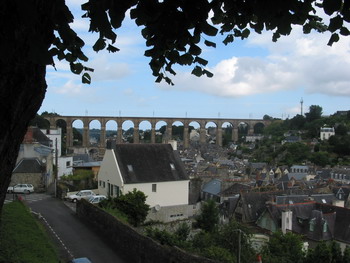
Morlaix was once the third largest city in Brittany. The viaduct crosses over the town and was built in 1863 (it is 191 feet high and 923 feet long).
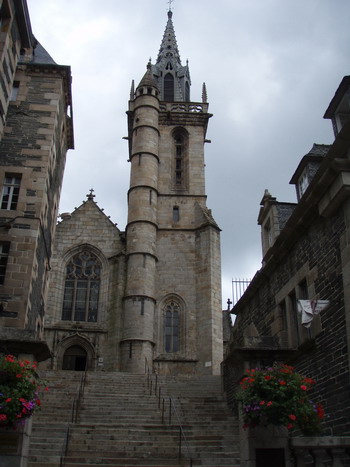
Saint Melaine's Church has a 17th century organ.
Again today Jim and Sietse decided on short notice to leave for the next port. The weather was better than forecasted and both yachts had their passage plans completed so the decision was made at noon to leave at 1230. Elma and I are getting used to this short notice to tidy up and get underway quickly. We hurried to get into the lock while it was open and then sat, tied up inside, for about 45 minutes. The longer we waited the more the tide flowed out of the river, making us a little nervous. Since we'd hit bottom and stuck on the way in we didn't want to do it on the way out with the tide flowing the wrong direction! All went well as the tide really was much higher than when we entered, we had an extra 1-2 meters under the keel. Plenty!
We motorsailed in the beginning but were able to sail once we turned more south towards Brest. The weather and wind, 10-13 kts. were perfect for sailing the tricky Chenal du Four. We arrived at the recommended time and were still prepared for the chop and a fast current in spots that the pilot books warned of but neither happened. The channel is well marked and it was fun sailing.
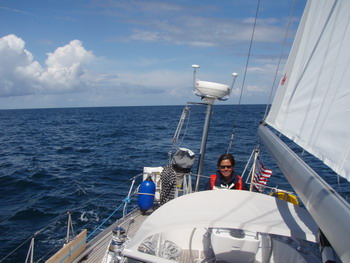
In the channel we averaged more than 6 knots until we turn the corner into the Rade de Brest. The 15 miles to Brest were with the wind at our back and we sailed wing 'n wing until the passage became too narrow.
The weather is not great and forecast poor for the next few days. We will use the time to enjoy Brest, work on boat projects, catch up on organizing our pictures, rest up and prepare meals to have on hand. Our next passage will be a big step for us. We will cross the Bay of Biscay, from Brest to La Coruna, Spain, a distance of about 350 miles in 3-5 days. This will be our first multi-day passage on Tenaya and our first alone.
The Bay of Biscay is a big challenge and even knowing that the challenge is mostly psychological it is still intimidating to me. I have read so many stories about the Bay, from the Patrick O'Brian novels to current day small boat crossings having storms, waves, nets fouling the propeller, etc. (not to mention the fact that the only officially recorded 100 wave was in the Bay of Biscay) that it is hard to take it as just our first multi day crossing. Besides being a little apprehensive I am also very excited and looking forward to the experience.
That was Jim writing ... Katie here... I have confidence in Tenaya, our sturdy Hallberg Rassy 40 and in our abilities to make the crossing if the weather is decent and the swell isn't bad. We will only leave here with a favorable forecast. Of course things could change once we're out there but, so far, the french forecasts along with those we've received from Commander's Weather have been very accurate. We've had a bit of experience on multi-day passages aboard Mahina and we both did fine. We now have more sailing experience (hand steering all day long) and can ward off seasickness, a potentially debilitating problem, so we are ready for the adventure. I look forward to spending time offshore and not coming into a port at days end. I am sure La Coruna will be a welcome site though!
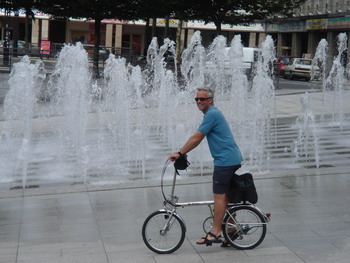
Once again we were pleased to have folding bicycles aboard as we explored the town of Brest.
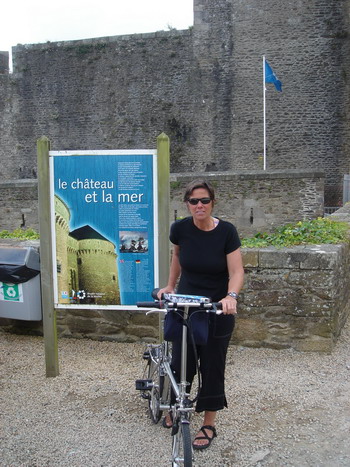
We visited the impressive Brest Castle which is unique in that it has retained its military vocation through 1700 years!
It was built as a fortified encampment by the Romans in 280 AD to protect the coast from attacks by Franc and Saxon pirates. It had 12 foot thick walls and 20 circular towers.
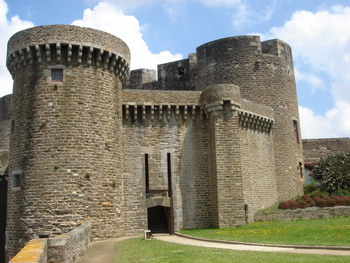
The English captured the Castle in 1342 and held it until 1392. In the 15th century it grew into an enclosed town with 260 houses and 1300 inhabitants. Duchess Anne lived here in 1505.
In 1592 6000 Catholics laid siege to the castle which was successfully defended by the Governor who remained faithful to Protestant King Henry IV. In 1631 Brest became a major navel port and by the 1700's the population had grown to 30,000 inhabitants.
Today it houses the headquarters of the French Navy for the Atlantic as well as the National Maritime Museum.
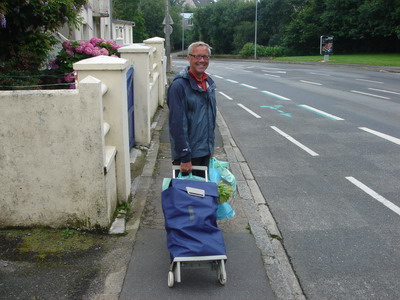
We leave to cross the Bay of Biscay tomorrow (Sunday July 29). Yesterday we loaded up at the supermarket. Katie thinks we have enough food to cross the Atlantic.
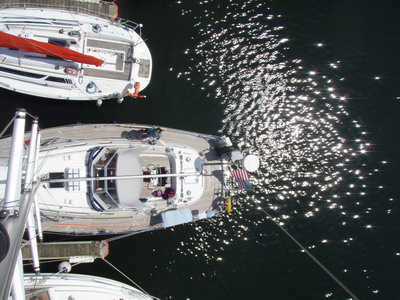
Before heading off again and after all the nose bashing Tenaya has taken so far, Jim went to the top of the mast to check that everything is in good condition. Call me (Katie) lazy but I'm sure happy we have electric winches.
.
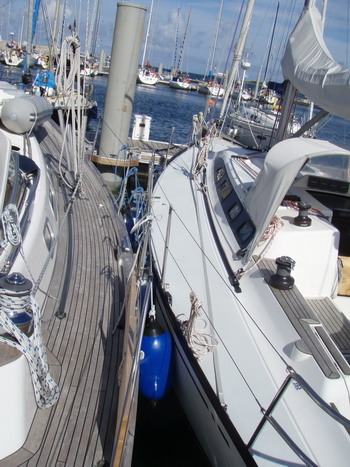
So far we have always found an available berth, but many were built for boats much narrower than today's designs. It is often challenging trying to fit into the available space.
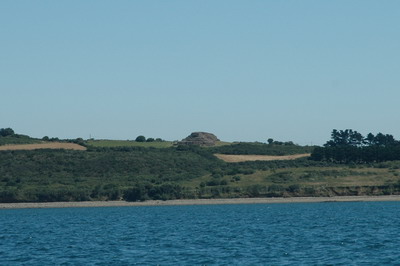
As we left Morlaix we had a good view of the Barnenez burial mound that dates back to approximately 4500 BC.
Brittany is known for a large number of megalithic monuments. The standing stones in Carnac alone number almost 3,000 and cover a distance of 2 1/2 miles. They date back to the Prehistoric age when the Brittany peninsula was already inhabited by man.
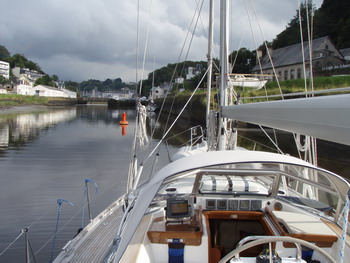
Leaving Morlaix
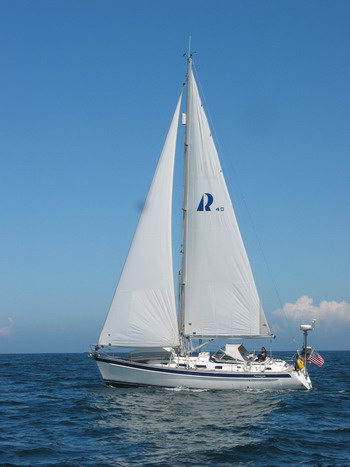
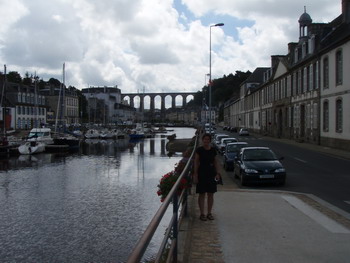
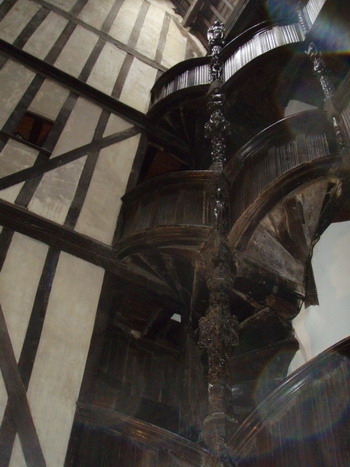
Duchess Anne's House was built in about 1500. The spiral staircase is supported by a column 36 feet high, formed from a single oak trunk and decorated with carvings of the house's patron saints. Houses of this style are called lantern houses because a single lantern was hung from a beam above the spiral staircase to illuminate the entire living area.

Katie was at the helm for our passage through the Chenal du Four, enjoying the challenge and the great sailing.

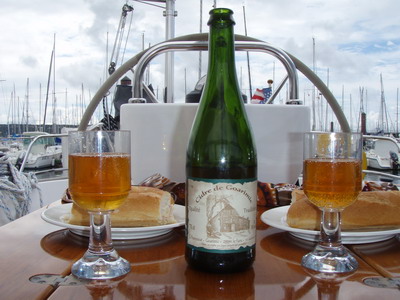
Waiting for good weather to cross the Bay of Biscay and enjoying the local cider
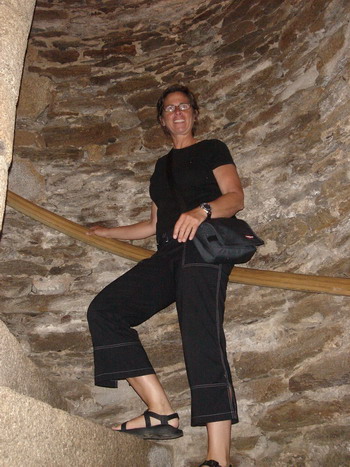
Exploring the castle. I love peeking in all the rooms and roaming up and down the hallways and staircases.
The castle was enormous, having been added on to and redesigned over the years. A few rooms held a lovely maritime themed art exhibit. Other rooms held models of navy ships, explained the naval history, the prison period history, and it's architectural history.
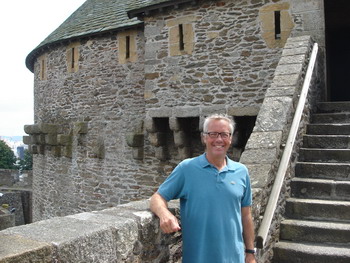
We were lucky to have a near perfect day for seeing the town of Brest. The following day it was very windy and rained all day.
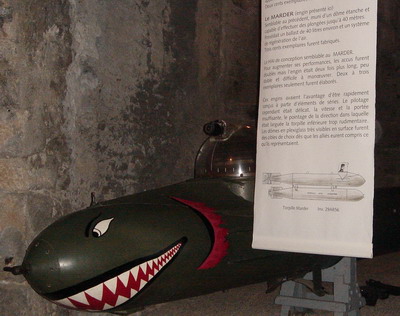
We aren't sure how this thing worked as our french wasn't up to the job of translation but it is obvious one man sat in this thing which carried a torpedo underneath. It was about 12 feet long and just wide enough for a person.
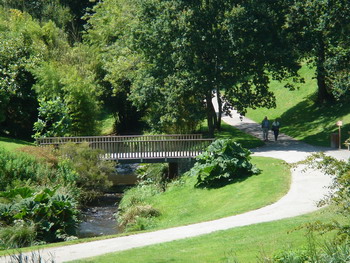
Close to the marina is this beautiful park filled with gardens, lakes and streams.
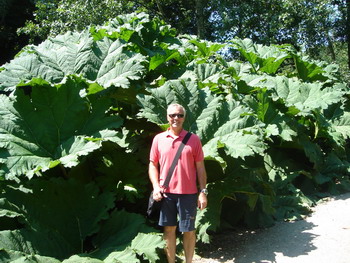
With the sun finally shining we enjoyed a walk through the park. These were the largest leaves we've ever seen!